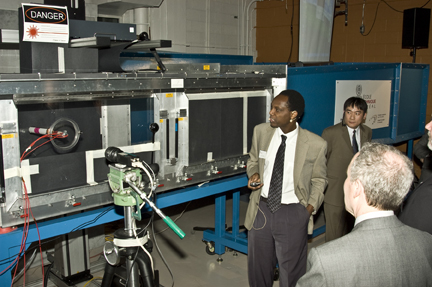Nouvelles
École Polytechnique de Montréal acquires a subsonic wind tunnel so that researchers can better understand and control fluid-structure interaction
How do you control airflow around airplane wings? How should wind turbine blades be shaped to increase energy production while reducing noise?How do you attenuate vibrations and reduce noise near airports? How can you construct electric cables to better resist wind forces? How can you prevent vibrations inside a nuclear reactor?
These are a few of the questions that interest some of the field's foremost pioneers: Professor Njuki W. Mureithi and his colleagues in Polytechnique's Department of Mechanical Engineering. The problem of fluid-structure interactions in industrial components remains a significant scientific challenge and few teams worldwide can match the expertise acquired by Polytechnique in fluid-structure interaction.
"The subsonic wind tunnel we have recently acquired allows us to simulate airflow at 300 kilometres an hour," said Professor Mureithi, who is Associate Chairholder of the NSERC/AECL/BWC Industrial Research Chair on Fluid-Structure Interaction. "We are now in a position to validate computer-assisted designs in conditions that approach reality. Through our research, we can reduce vibration, erosion and damage to various key components of high technology apparatus."
At the launch, with cameras present, Polytechnique professors Njuki Mureithi and Huu Duc Vo tested a new technology that uses plasma to control the vibration of a cylinder. The groundbreaking technology is expected to improve airplane wing design, stability and engine performance. Presently researched at only a handful of institutions worldwide, the technology is attracting increasing notice from the aeronautics industry.
In addition to benefiting industry through technology transfers, the wind tunnel will be used for applied research and to train highly qualified workers. "Some 14 students are currently researching fluid-structure dynamics at the master's and doctoral levels. And this number is expected to increase in coming years, heralding a new generation of scientists to support innovation," said Christophe Guy, École Polytechnique's Chief Executive Officer.
"The Canadian Foundation for Innovation is proud to play a part in furthering knowledge and enhancing the quality of research and training in research institutions across Canada," stated Dr. Eliot Phillipson, President and CEO of the CFI. "Our financial support of the infrastructure being launched today corresponds exactly to our mission."
Acquisition and installation of the state-of-the-art infrastructure was made possible through the Canada Foundation for Innovation and Québec's Ministère de l'Éducation, du Loisir et du Sport, each of which contributed $223,104. Representing a total investment of over $860,000, the project also received support from Dantec Dynamics Inc., ELD Inc., SKF Magnetic Bearings and École Polytechnique.
In addition to the subsonic wind tunnel, Polytechnique's laboratory also acquired a precision two-phase loop to study the dynamic properties and stability of multiphase flows; a magnetic-bearing dynamic spin rig to study the dynamics of rotating machines; and a stereoscopic PIV (particle image velocimetry) system to optically measure airflow.





